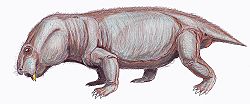| Therochelonia Temporal range: | |
|---|---|
 | |
| Life restoration of Cistecephalus Cistecephalus microrhinus | |
| Scientific classification | |
| Domain: | Eukaryota |
| Kingdom: | Animalia |
| Phylum: | Chordata |
| Clade: | Synapsida |
| Clade: | Therapsida |
| Suborder: | † Anomodontia |
| Clade: | † Dicynodontia |
| Clade: | † Therochelonia Seeley, 1894 |
| Subgroups | |
See text. | |
Therochelonia is a group of dicynodont therapsids. The group was named by British paleontologist Harry Seeley in 1894 and fell into disuse in the following century. Therochelonia was redefined as a node-based clade in 2009. It is defined as the last common ancestor of Cistecephalus microrhinus and Dicynodon lacerticeps , and all of its descendants. [1] Below is a simplified cladogram from Kammerer et al. (2011) showing the phylogenetic placement of Therochelonia: [2]





